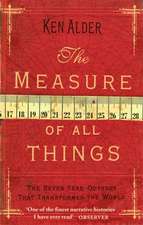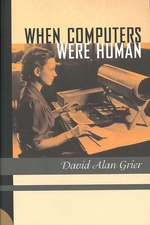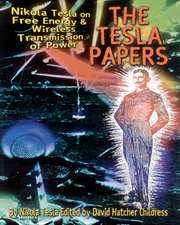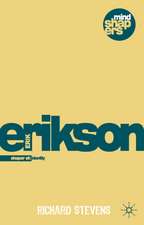Shadows: Unlocking Their Secrets, from Plato to Our Time
Autor Roberto Casatien Limba Engleză Paperback – 31 iul 2004
For Plato, shadows were the symbol of our limitations. For Galileo, they knocked the Earth from the center of the cosmos. They are a source of fear and a symbol of ignorance, and they loom large in art and design, mythology and folklore, physics and metaphysics, and architecture and urban planning. From shadows puppets and the psychology of shadows to the role of shadows in astronomy and the influence of shadows on the architectural profiles of our cities, Roberto Casati awakens our fascination in this tour-de-force of investigation and imagination.
Preț: 97.80 lei
Nou
Puncte Express: 147
Preț estimativ în valută:
18.71€ • 19.54$ • 15.45£
18.71€ • 19.54$ • 15.45£
Carte disponibilă
Livrare economică 25 martie-08 aprilie
Preluare comenzi: 021 569.72.76
Specificații
ISBN-13: 9780375707117
ISBN-10: 0375707115
Pagini: 240
Ilustrații: 78 ILLUSTRATIONS IN TEXT
Dimensiuni: 133 x 205 x 17 mm
Greutate: 0.26 kg
Editura: Vintage Publishing
ISBN-10: 0375707115
Pagini: 240
Ilustrații: 78 ILLUSTRATIONS IN TEXT
Dimensiuni: 133 x 205 x 17 mm
Greutate: 0.26 kg
Editura: Vintage Publishing
Notă biografică
Roberto Casati was born in Milan in 1961. A research director at the Centre National de la Réchérche Scientifique, he lives in Paris and works at the Institut Nicod, a laboratory of the École des Hautes Études en Sciences Sociales and of the École Normale. He studies the cognition of strange things—images, colors, sounds, places, holes—and shadows. With Achille Varzi he is the author of Holes and Other Superficialities and Parts and Places.
Abigail Asher (translator) is an editor of art history and other nonfiction books. She has lived and worked in publishing in Italy; she now lives and works in New York City. This is her first book-length translation.
Abigail Asher (translator) is an editor of art history and other nonfiction books. She has lived and worked in publishing in Italy; she now lives and works in New York City. This is her first book-length translation.
Extras
I In the Beginning There Was Shadow
The Earth was without form, and void;
And darkness was on the face of the deep.
—Genesis 1:2
Darest thou, monster,
Here beside beauty
Under the eye of great
Phoebus to show thee?
Come, only step forth, notwithstanding,
For the hideous sees he not,
As his holy eye has not
Yet alighted on shadow.
—Goethe, Faust
A Very Relaxed Beginning
The first time I watched a lunar eclipse carefully was shortly after midnight on April 4, 1996. If you ever find yourself observing such an eclipse, you should know that it’s important to have a very comfortable chair. I’m no great fan of long sessions outdoors on humid country nights, and I probably would not have watched the eclipse if I hadn’t had the option of doing it easily from my home in Paris. The moon was per- fectly framed in the window (at the time, I lived at the top of a skyscraper), and it shone magnificently, despite pollution from the light of the ville lumière.
I had thought that the interesting part of an eclipse would be the shadow of the earth slipping slowly across the moon, and the chance to look into the sky and see a shaft of black negative light. This expectation was indeed fulfilled: right on schedule, the earth’s shadow cone dimmed and then completely extinguished the moonshine. But at that point, in the moment of total eclipse, I had—pardon the expression—an illumination.
For the first time, I saw the moon for what it really was, and I wanted to put it down in words. The moon is a fairly large, shadowy rock hanging a certain distance over my head; oddly, it doesn’t fall down and hit me. Naturally, I knew about the laws that kept it safely in orbit; but my eyes, unaccustomed to seeing stones hanging in the sky, didn’t want to believe it. Likewise, it had escaped my notice that the moon was—as I knew perfectly well—a huge dark rock; usually the diaphanous glow of the lunar surface tricks the eye with the illusion that it’s a delicate, airy lantern.
During an eclipse the moon loses its character as demigoddess: it splits off itself from the royal court of the other visible, shining celestial objects. Even those planets that are dark like the moon and glow with reflected light aren’t seen as planets: our not very selective vision lumps them in together with the stars. Light offers the moon a weightlessness that renders it more acceptable—makes it seem almost normal that the moon should sail in the night like a paper lantern hung from the black ceiling of the sky.
So the shadow of the earth reveals the true nature of the moon.
Since that night I haven’t stopped thinking about shadows. Up till then I had considered them to be an interesting example of a strange, not very clearly identified object, with some philosophical complexi- ties. (Strange objects are always thought-provoking for philosophers.) Beyond this narrow theoretical interest, shadows simply registered on me with the low, negative associations that our culture has (and many other cultures have) bound them up with: that shadows are for hiding in and plotting in; that shadows are dark and worrisome. All of a sudden, as I watched the eclipse drawing to a close, shadows seemed much more important and worthy of attention. If shadows can forever change the way we think about the moon—expelling it from the Olympus of the gods to imprison it in the world of minerals, in a spectacular comedown, the opposite of the ascent through the chain of being—then shadows are valuable tools of knowledge. They don’t hide: they reveal.
In other words, too much light can be harmful. And yet some people can never get enough light, as we know from one of the most famous images in Western literature, described below.
A Completely Different Beginning
We enter a corridor that leads underground. In a poorly lighted room are the subjects of the experiment. Ever since birth they have been kept in the dark about what happens outside. For even greater security they are in shackles. Looking more closely, we see that they are bound in such a way that they cannot see one another and they are all forced to look in the same direction. The only distraction—which is, however, a crucial part of the experiment of which the prisoners are, unbeknownst to them, the subject—is a strange spectacle taking place on the spot they all see. The subjects don’t know that their lives are exceptional, and they have spent many years watching the scene without the option of looking away. It is explained to us that the experiment has been a success so far: the subjects believe that the show is the sum total of reality, and the actors are the only inhabitants of the real world. (At this point we wonder what the show is. We would like to understand what the prisoners have learned in all these years.) We discover that the designers of the experiment have created a clever scene. The actors are not flesh-and-blood people with their own voices and their own free will, but rather statues brought to life by an army of attendants going up and down a catwalk hidden behind a low wall. And that’s not all. The prisoners don’t even see the statues. The low wall over which the statues protrude is located not in front of the prisoners but behind them. A bonfire makes the statues project a shadow on the front wall, the wall that prisoners are made to face.
The prisoners have always seen only shadow theater, and this is why their minds are a thousand miles away from the real world. Of course, only a rough caricature of the universe would have been provided by a normal stage show or, even more roughly, by a show of statues or marionettes. But a shadow theater provides even less: it’s the image of an image.
But what’s the point of this complicated staging? We are told that the crucial phase of the experiment has yet to begin. Keeping the prisoners in shackles for all these years has served to distance them from reality. What will happen when one of these prisoners is given the opportunity to leave the bowels of the earth and discover the world of things and the sunlight that gives those things shape and color? The hypothesis is that the prisoners exiting the cave will first be blinded by the light and then, when they can see again, will marvel at the existence of a world of colorful three-dimensional things. For too long they have been deceived by the flat and colorless world of shadows.
This experiment, fortunately only imaginary, is described in the seventh book of the Republic by Plato (427–347 b.c.), written more than two thousand years ago, between 388 and 367 b.c. What Plato wanted to suggest with the picture of the cave is that we are like the prisoners in the experiment, even though we consider ourselves to be free and well informed and even though we haven’t spent our lives in chains watching shadow theater. The prisoners see the shadows, they don’t believe anything else exists, and they lose the chance to know about real objects. In turn, we who see objects (and not just shadows) are unable to consider their true hidden nature, which would mean digging under the surface of things. Our consciousness, like that of the prisoners, is locked up in an image. And what if a prisoner emerges into the light and then returns to the cave and tries to convince those inside that a better world exists? He will only be ridiculed by his former companions. His vision will be weakened when he goes back into the cave, and his companions will think that the light he praises so highly is instead damaging. According to Plato, this is what will happen to the philosopher who tries to explain the truth to other humans.
Now let’s try to focus on the situation of the prisoners.
The first fact is that there was no reason to use shadows for this experiment. The statues, the marionettes, would have sufficed. To be perfectly logical, even flesh-and-blood actors would have served to make us ponder the distinction between image and reality. Why did Plato choose shadows? One answer is that shadows are a disturbing example of lesser entities: they are a diminution of the objects that project them. They are flat, immaterial, and without qualities, without color. Their outlines enclose an indistinct interior. But above all they are absences, negative things. A shadow is a lack of light. Negative things are bizarre. In the end, actors and attendants are on the payroll of the theater. Even marionettes are counted, during inventory. But shadows are not listed anywhere. These uncertain beings confuse the mind; they trouble us. As if that weren’t enough, shadows have always been surrounded by suspicion and fear. They are strange entities: we don’t know much about them, but we do know that they’re not a happy bunch. Plato is right to use them if he wants to worry us.
There’s more. For Plato it went without saying that shadows keep us at a certain remove from knowledge. They are a screen between the prisoners and the truth. And yet, despite their unhappy condition, despite the fact that the theater’s paltry tricks impose a distance between them and reality—despite all this, the prisoners have some reason for optimism. They can study the shadows carefully. They can reconstruct the three-dimensional forms of the objects casting the shadows. They can grasp the mathematical beauty of the relationship between an object and its shadow. Approached in a certain way, the shadows turn out to be a magnificent tool for knowledge. This is why in the final analysis Plato’s experiment is not convincing. Shadows can be used to reconstruct the world. And indeed we continually use them to understand the shape of our environment.
Just Imagine a World Without Shadows
If light is the instrument of vision, shadow must be its great antagonist. One hides in the shadows because a searcher’s gaze cannot penetrate the darkness. But it’s also true that vision can’t do without shadow: the information carried by shadow is a fundamental aid to seeing. Evolution has recognized that the world is full of shadows and it has selected biological systems that adapt to levels of darkness. Why do many animal species have bellies paler than their backs? Because light comes mostly from above: the pale spot on the belly counteracts the inevitable shadow. Thus the animal hardly stands out, and he is less easy to see. Here evolution was betting on the fact that the visual system of the predator was hunting for shadows.
Things could have gone differently. Permit me to develop this hypothesis, though I’ll need to rewrite the laws of physics. Let’s say that all the objects in the universe were dimly phosphorescent. The slight bit of light they gave off would make only weak shadows. But these shadows would fall on phosphorescent surfaces and be canceled out. In such a universe evolution would have had no reason to create eyes that notice shadow, as was the case in our world. Our vision is so bewitched by chiaroscuro that if we were to find ourselves suddenly in a shadowless world, everything would seem insubstantial and without depth.
Here’s another example of a world without visible shadows. If our eyes were fitted with lamps, we would never see the shadows they cast: the shadow would always be hidden by the object making the shadow. The sun’s view of the world is immaculate because the sun “has not yet alighted on shadow,” as Goethe wrote in Faust.
Immaculate it may be; but it certainly is flat. Rooms and faces photographed with a flash are flat. In images where we have erased the shadows, objects are flat and they lack context.
The opposite is also true: erasing the light eliminates relief. In what may have been the first experiment ever conceived of in cognitive science, Galileo Galilei (1564–1642) suggested blackening the unshadowed parts of a statue in order to eliminate the chiaroscuro. His hypothesis was that the statue would appear to be without relief—flat. Galileo wanted to show the superiority of painting over sculpture. In modern terms, the experiment shows that it’s not enough to have good volume in order to look like an object with good volume: you also have to make the right impression. Putting on makeup does the same thing: augmenting the darkness of a part that’s slightly shadowed gives your face the appearance of greater depth.
Cast shadows have been removed from this painting by Jean-Baptiste-Siméon Chardin, Copper Urn. As a result, the objects are “floating.” Then the contrast was eliminated from the picture, and it was lightened. As a result, the objects lose their solidity. (Graphic manipulation by W. Criscuoli.)
But what can be said about the world that so frightened Plato, a world in which perception depends on shadows exclusively? We know part of the answer. In 1953 the psychologists Hans Wallach and D. N. O’Connell actually carried out a variation on the cave experiment. First they took a piece of stiff wire and bent it irregularly. Then they hid it behind a screen and had a lamp project a shadow of the wire. All the observers saw was the shadow of the bent wire on the screen. If the wire stayed still, observers would see a stringy black mark like a hand-sketched line. But the wire was actually mounted on a turntable. As soon as the turntable began to move, the projection of the shadow on the screen changed. Just as in Plato’s cave, all the observers had to work with were the dancing shadows, two-dimensional figures playing tag. But they did not in fact perceive a deformed black mark stretching and shrinking: they had the distinct impression of a three-dimensional wire spinning in space. The brain works feverishly to extract solid structures from a changing reality of shifting perspectives. One might say these observers are different from the prisoners in the cave; Wallach and O’Connell’s observers were not kept in chains and obligated to look only at shadows from infancy. Their brains could have learned to see three-dimensional things, while those of Plato’s prisoners might have been affected by their strange upbringing in the cave. But it’s also true that for countless generations our ancestors brains were immersed in a world of rigid three-dimensional objects, and we inherited a propensity to see solid things. This propensity kicks in on the slightest pretext and makes us see objects even where there is nothing but shadows. In a world made entirely of shadows, our brains might manage better than Plato suspected.
Certainly, we now know more about perception than was known in ancient Greece (although the experiment by Wallach and O’Connell requires equipment so simple that it could have been done in the fifth century b.c.: just replace the turntable with a turning lathe). Are we being unfair to Plato?
From the Hardcover edition.
The Earth was without form, and void;
And darkness was on the face of the deep.
—Genesis 1:2
Darest thou, monster,
Here beside beauty
Under the eye of great
Phoebus to show thee?
Come, only step forth, notwithstanding,
For the hideous sees he not,
As his holy eye has not
Yet alighted on shadow.
—Goethe, Faust
A Very Relaxed Beginning
The first time I watched a lunar eclipse carefully was shortly after midnight on April 4, 1996. If you ever find yourself observing such an eclipse, you should know that it’s important to have a very comfortable chair. I’m no great fan of long sessions outdoors on humid country nights, and I probably would not have watched the eclipse if I hadn’t had the option of doing it easily from my home in Paris. The moon was per- fectly framed in the window (at the time, I lived at the top of a skyscraper), and it shone magnificently, despite pollution from the light of the ville lumière.
I had thought that the interesting part of an eclipse would be the shadow of the earth slipping slowly across the moon, and the chance to look into the sky and see a shaft of black negative light. This expectation was indeed fulfilled: right on schedule, the earth’s shadow cone dimmed and then completely extinguished the moonshine. But at that point, in the moment of total eclipse, I had—pardon the expression—an illumination.
For the first time, I saw the moon for what it really was, and I wanted to put it down in words. The moon is a fairly large, shadowy rock hanging a certain distance over my head; oddly, it doesn’t fall down and hit me. Naturally, I knew about the laws that kept it safely in orbit; but my eyes, unaccustomed to seeing stones hanging in the sky, didn’t want to believe it. Likewise, it had escaped my notice that the moon was—as I knew perfectly well—a huge dark rock; usually the diaphanous glow of the lunar surface tricks the eye with the illusion that it’s a delicate, airy lantern.
During an eclipse the moon loses its character as demigoddess: it splits off itself from the royal court of the other visible, shining celestial objects. Even those planets that are dark like the moon and glow with reflected light aren’t seen as planets: our not very selective vision lumps them in together with the stars. Light offers the moon a weightlessness that renders it more acceptable—makes it seem almost normal that the moon should sail in the night like a paper lantern hung from the black ceiling of the sky.
So the shadow of the earth reveals the true nature of the moon.
Since that night I haven’t stopped thinking about shadows. Up till then I had considered them to be an interesting example of a strange, not very clearly identified object, with some philosophical complexi- ties. (Strange objects are always thought-provoking for philosophers.) Beyond this narrow theoretical interest, shadows simply registered on me with the low, negative associations that our culture has (and many other cultures have) bound them up with: that shadows are for hiding in and plotting in; that shadows are dark and worrisome. All of a sudden, as I watched the eclipse drawing to a close, shadows seemed much more important and worthy of attention. If shadows can forever change the way we think about the moon—expelling it from the Olympus of the gods to imprison it in the world of minerals, in a spectacular comedown, the opposite of the ascent through the chain of being—then shadows are valuable tools of knowledge. They don’t hide: they reveal.
In other words, too much light can be harmful. And yet some people can never get enough light, as we know from one of the most famous images in Western literature, described below.
A Completely Different Beginning
We enter a corridor that leads underground. In a poorly lighted room are the subjects of the experiment. Ever since birth they have been kept in the dark about what happens outside. For even greater security they are in shackles. Looking more closely, we see that they are bound in such a way that they cannot see one another and they are all forced to look in the same direction. The only distraction—which is, however, a crucial part of the experiment of which the prisoners are, unbeknownst to them, the subject—is a strange spectacle taking place on the spot they all see. The subjects don’t know that their lives are exceptional, and they have spent many years watching the scene without the option of looking away. It is explained to us that the experiment has been a success so far: the subjects believe that the show is the sum total of reality, and the actors are the only inhabitants of the real world. (At this point we wonder what the show is. We would like to understand what the prisoners have learned in all these years.) We discover that the designers of the experiment have created a clever scene. The actors are not flesh-and-blood people with their own voices and their own free will, but rather statues brought to life by an army of attendants going up and down a catwalk hidden behind a low wall. And that’s not all. The prisoners don’t even see the statues. The low wall over which the statues protrude is located not in front of the prisoners but behind them. A bonfire makes the statues project a shadow on the front wall, the wall that prisoners are made to face.
The prisoners have always seen only shadow theater, and this is why their minds are a thousand miles away from the real world. Of course, only a rough caricature of the universe would have been provided by a normal stage show or, even more roughly, by a show of statues or marionettes. But a shadow theater provides even less: it’s the image of an image.
But what’s the point of this complicated staging? We are told that the crucial phase of the experiment has yet to begin. Keeping the prisoners in shackles for all these years has served to distance them from reality. What will happen when one of these prisoners is given the opportunity to leave the bowels of the earth and discover the world of things and the sunlight that gives those things shape and color? The hypothesis is that the prisoners exiting the cave will first be blinded by the light and then, when they can see again, will marvel at the existence of a world of colorful three-dimensional things. For too long they have been deceived by the flat and colorless world of shadows.
This experiment, fortunately only imaginary, is described in the seventh book of the Republic by Plato (427–347 b.c.), written more than two thousand years ago, between 388 and 367 b.c. What Plato wanted to suggest with the picture of the cave is that we are like the prisoners in the experiment, even though we consider ourselves to be free and well informed and even though we haven’t spent our lives in chains watching shadow theater. The prisoners see the shadows, they don’t believe anything else exists, and they lose the chance to know about real objects. In turn, we who see objects (and not just shadows) are unable to consider their true hidden nature, which would mean digging under the surface of things. Our consciousness, like that of the prisoners, is locked up in an image. And what if a prisoner emerges into the light and then returns to the cave and tries to convince those inside that a better world exists? He will only be ridiculed by his former companions. His vision will be weakened when he goes back into the cave, and his companions will think that the light he praises so highly is instead damaging. According to Plato, this is what will happen to the philosopher who tries to explain the truth to other humans.
Now let’s try to focus on the situation of the prisoners.
The first fact is that there was no reason to use shadows for this experiment. The statues, the marionettes, would have sufficed. To be perfectly logical, even flesh-and-blood actors would have served to make us ponder the distinction between image and reality. Why did Plato choose shadows? One answer is that shadows are a disturbing example of lesser entities: they are a diminution of the objects that project them. They are flat, immaterial, and without qualities, without color. Their outlines enclose an indistinct interior. But above all they are absences, negative things. A shadow is a lack of light. Negative things are bizarre. In the end, actors and attendants are on the payroll of the theater. Even marionettes are counted, during inventory. But shadows are not listed anywhere. These uncertain beings confuse the mind; they trouble us. As if that weren’t enough, shadows have always been surrounded by suspicion and fear. They are strange entities: we don’t know much about them, but we do know that they’re not a happy bunch. Plato is right to use them if he wants to worry us.
There’s more. For Plato it went without saying that shadows keep us at a certain remove from knowledge. They are a screen between the prisoners and the truth. And yet, despite their unhappy condition, despite the fact that the theater’s paltry tricks impose a distance between them and reality—despite all this, the prisoners have some reason for optimism. They can study the shadows carefully. They can reconstruct the three-dimensional forms of the objects casting the shadows. They can grasp the mathematical beauty of the relationship between an object and its shadow. Approached in a certain way, the shadows turn out to be a magnificent tool for knowledge. This is why in the final analysis Plato’s experiment is not convincing. Shadows can be used to reconstruct the world. And indeed we continually use them to understand the shape of our environment.
Just Imagine a World Without Shadows
If light is the instrument of vision, shadow must be its great antagonist. One hides in the shadows because a searcher’s gaze cannot penetrate the darkness. But it’s also true that vision can’t do without shadow: the information carried by shadow is a fundamental aid to seeing. Evolution has recognized that the world is full of shadows and it has selected biological systems that adapt to levels of darkness. Why do many animal species have bellies paler than their backs? Because light comes mostly from above: the pale spot on the belly counteracts the inevitable shadow. Thus the animal hardly stands out, and he is less easy to see. Here evolution was betting on the fact that the visual system of the predator was hunting for shadows.
Things could have gone differently. Permit me to develop this hypothesis, though I’ll need to rewrite the laws of physics. Let’s say that all the objects in the universe were dimly phosphorescent. The slight bit of light they gave off would make only weak shadows. But these shadows would fall on phosphorescent surfaces and be canceled out. In such a universe evolution would have had no reason to create eyes that notice shadow, as was the case in our world. Our vision is so bewitched by chiaroscuro that if we were to find ourselves suddenly in a shadowless world, everything would seem insubstantial and without depth.
Here’s another example of a world without visible shadows. If our eyes were fitted with lamps, we would never see the shadows they cast: the shadow would always be hidden by the object making the shadow. The sun’s view of the world is immaculate because the sun “has not yet alighted on shadow,” as Goethe wrote in Faust.
Immaculate it may be; but it certainly is flat. Rooms and faces photographed with a flash are flat. In images where we have erased the shadows, objects are flat and they lack context.
The opposite is also true: erasing the light eliminates relief. In what may have been the first experiment ever conceived of in cognitive science, Galileo Galilei (1564–1642) suggested blackening the unshadowed parts of a statue in order to eliminate the chiaroscuro. His hypothesis was that the statue would appear to be without relief—flat. Galileo wanted to show the superiority of painting over sculpture. In modern terms, the experiment shows that it’s not enough to have good volume in order to look like an object with good volume: you also have to make the right impression. Putting on makeup does the same thing: augmenting the darkness of a part that’s slightly shadowed gives your face the appearance of greater depth.
Cast shadows have been removed from this painting by Jean-Baptiste-Siméon Chardin, Copper Urn. As a result, the objects are “floating.” Then the contrast was eliminated from the picture, and it was lightened. As a result, the objects lose their solidity. (Graphic manipulation by W. Criscuoli.)
But what can be said about the world that so frightened Plato, a world in which perception depends on shadows exclusively? We know part of the answer. In 1953 the psychologists Hans Wallach and D. N. O’Connell actually carried out a variation on the cave experiment. First they took a piece of stiff wire and bent it irregularly. Then they hid it behind a screen and had a lamp project a shadow of the wire. All the observers saw was the shadow of the bent wire on the screen. If the wire stayed still, observers would see a stringy black mark like a hand-sketched line. But the wire was actually mounted on a turntable. As soon as the turntable began to move, the projection of the shadow on the screen changed. Just as in Plato’s cave, all the observers had to work with were the dancing shadows, two-dimensional figures playing tag. But they did not in fact perceive a deformed black mark stretching and shrinking: they had the distinct impression of a three-dimensional wire spinning in space. The brain works feverishly to extract solid structures from a changing reality of shifting perspectives. One might say these observers are different from the prisoners in the cave; Wallach and O’Connell’s observers were not kept in chains and obligated to look only at shadows from infancy. Their brains could have learned to see three-dimensional things, while those of Plato’s prisoners might have been affected by their strange upbringing in the cave. But it’s also true that for countless generations our ancestors brains were immersed in a world of rigid three-dimensional objects, and we inherited a propensity to see solid things. This propensity kicks in on the slightest pretext and makes us see objects even where there is nothing but shadows. In a world made entirely of shadows, our brains might manage better than Plato suspected.
Certainly, we now know more about perception than was known in ancient Greece (although the experiment by Wallach and O’Connell requires equipment so simple that it could have been done in the fifth century b.c.: just replace the turntable with a turning lathe). Are we being unfair to Plato?
From the Hardcover edition.
Recenzii
“Casati’s short, lively book . . . will delight.” —San Francisco Chronicle
“Striking. . . . Shadows succeeds in throwing a little light on the Dark Side.” —Seed
“A refined chronicle of art and science.” —Booklist
“A blend of scientific inquiry and philosophy. . . . Casati comes up with some enlightening answers.” —San Diego Union-Tribune
“Striking. . . . Shadows succeeds in throwing a little light on the Dark Side.” —Seed
“A refined chronicle of art and science.” —Booklist
“A blend of scientific inquiry and philosophy. . . . Casati comes up with some enlightening answers.” —San Diego Union-Tribune
















